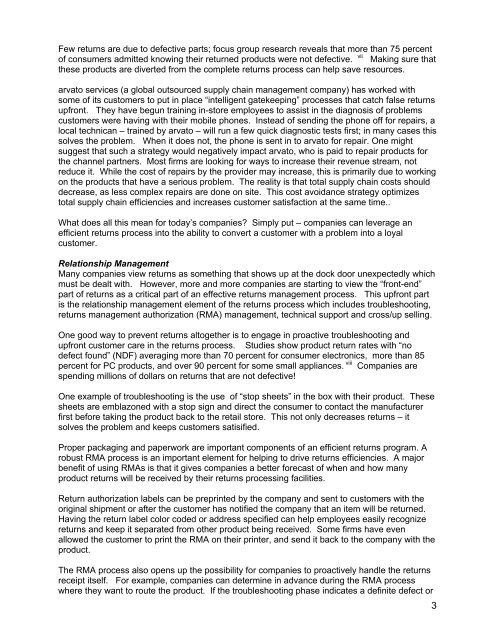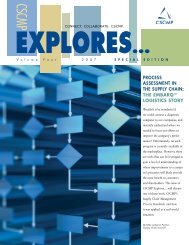Return Profits From Returns: Leveraging all 5 R's - Supply Chain ...
Return Profits From Returns: Leveraging all 5 R's - Supply Chain ...
Return Profits From Returns: Leveraging all 5 R's - Supply Chain ...
Create successful ePaper yourself
Turn your PDF publications into a flip-book with our unique Google optimized e-Paper software.
Few returns are due to defective parts; focus group research reveals that more than 75 percent<br />
of consumers admitted knowing their returned products were not defective. vii Making sure that<br />
these products are diverted from the complete returns process can help save resources.<br />
arvato services (a global outsourced supply chain management company) has worked with<br />
some of its customers to put in place “intelligent gatekeeping” processes that catch false returns<br />
upfront. They have begun training in-store employees to assist in the diagnosis of problems<br />
customers were having with their mobile phones. Instead of sending the phone off for repairs, a<br />
local technican – trained by arvato – will run a few quick diagnostic tests first; in many cases this<br />
solves the problem. When it does not, the phone is sent in to arvato for repair. One might<br />
suggest that such a strategy would negatively impact arvato, who is paid to repair products for<br />
the channel partners. Most firms are looking for ways to increase their revenue stream, not<br />
reduce it. While the cost of repairs by the provider may increase, this is primarily due to working<br />
on the products that have a serious problem. The reality is that total supply chain costs should<br />
decrease, as less complex repairs are done on site. This cost avoidance strategy optimizes<br />
total supply chain efficiencies and increases customer satisfaction at the same time..<br />
What does <strong>all</strong> this mean for today’s companies? Simply put – companies can leverage an<br />
efficient returns process into the ability to convert a customer with a problem into a loyal<br />
customer.<br />
Relationship Management<br />
Many companies view returns as something that shows up at the dock door unexpectedly which<br />
must be dealt with. However, more and more companies are starting to view the “front-end”<br />
part of returns as a critical part of an effective returns management process. This upfront part<br />
is the relationship management element of the returns process which includes troubleshooting,<br />
returns management authorization (RMA) management, technical support and cross/up selling.<br />
One good way to prevent returns altogether is to engage in proactive troubleshooting and<br />
upfront customer care in the returns process. Studies show product return rates with “no<br />
defect found” (NDF) averaging more than 70 percent for consumer electronics, more than 85<br />
percent for PC products, and over 90 percent for some sm<strong>all</strong> appliances. viii Companies are<br />
spending millions of dollars on returns that are not defective!<br />
One example of troubleshooting is the use of “stop sheets” in the box with their product. These<br />
sheets are emblazoned with a stop sign and direct the consumer to contact the manufacturer<br />
first before taking the product back to the retail store. This not only decreases returns – it<br />
solves the problem and keeps customers satisified.<br />
Proper packaging and paperwork are important components of an efficient returns program. A<br />
robust RMA process is an important element for helping to drive returns efficiencies. A major<br />
benefit of using RMAs is that it gives companies a better forecast of when and how many<br />
product returns will be received by their returns processing facilities.<br />
<strong>Return</strong> authorization labels can be preprinted by the company and sent to customers with the<br />
original shipment or after the customer has notified the company that an item will be returned.<br />
Having the return label color coded or address specified can help employees easily recognize<br />
returns and keep it separated from other product being received. Some firms have even<br />
<strong>all</strong>owed the customer to print the RMA on their printer, and send it back to the company with the<br />
product.<br />
The RMA process also opens up the possibility for companies to proactively handle the returns<br />
receipt itself. For example, companies can determine in advance during the RMA process<br />
where they want to route the product. If the troubleshooting phase indicates a definite defect or<br />
3




